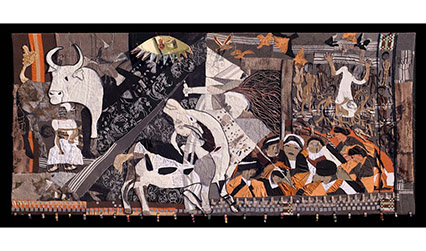In honour of our 500th anniversary, the RCP has commissioned a tapestry from South African charity the Keiskamma Trust. The Trust looks after a number of charitable initiatives which aim to tackle poverty, depression and health issues in the rural village of Hamburg through art, music and healthcare services. Created by artists working with the Trust, the tapestry brings together iconic imagery from 500 years of RCP history. But can you identify these representations of artworks and objects?

The RCP’s Keiskamma Tapestry is a celebration of 500 years of history and a visual compendium of key spaces, moments and personalities from last five centuries. At the centre of the piece is the RCP’s current home, our Grade-I listed building in Regent’s Park by modernist architect Sir Denys Lasdun (1914–2001). This central image is bordered by beaded representations of two of our key ceremonial artefacts: the caduceus (1556) and the mace (1684). Below the Regent’s Park building images from our rare books collection are shown, in particular illustrations of medicinal plants – a reference our medicinal garden and many volumes on the subject. In the bottom row of images, the RCP’s former homes are represented, separated by the stained glass from our building in Pall Mall which still resides at the RCP today.

To the left and right of the tapestry are iconic images and personalities from RCP history. On the left, William Harvey’s classic illustration of the veins and arteries are reproduced from his ground-breaking volume De motu cordis (1628), in which he announced his discovery of the circulation of the blood. Below this are three key early figures from the RCP’s history: Harvey himself, Henry VIII and RCP founder Thomas Linacre (1460-1524). On the right, the College coat of arms is displayed above three formative figures from our 20th century history: Denys Lasdun, Lord Robert Platt (1900–1978), the president who commissioned our current building, and Dame Margaret Turner-Warwick (1924–2017), our first female president.

The Keiskamma Art Project was founded in 2000 by Dr Carol Hofmeyr as a means of raising hope and esteem and building relationships amongst the women of Hamburg, a small rural village in the Eastern Cape of South Africa. Hamburg has over 90% unemployment and by 2000 most residents were marginalised following years of racial conflict and forced removals. The art project grew to include health and then music and education programs in trying to work with the community in a holistic manner. From 2004, the Trust became the only medical program with access to anti-retroviral medical in South Africa. In more recent years, the organization has worked closely with government clinics to assist in training and education of HIV positive people to treatment options.

The embroidered artworks produced by the art project are bold and often challenging. The Trust produced the ‘Keiskamma Guernica’ in 2010, a large-scale tapestry to the same dimensions as Pablo Picasso’s famous piece of the same name. Picasso’s ‘Guernica’ (1937) is a visceral reaction to the violence of the Spanish Civil War. Arguably the artist’s most famous work, the scenes of violence depicted in the enormous 3.5 meter tall painting were directly inspired by the Nazi bombing of the Basque town of Guernica. Taking inspiration from Picasso’s work, the ‘Keiskamma Guernica’ is a powerful reaction to the HIV/AIDS epidemic in South Africa. Through re-making the painting and adding imagery of local relevance, the creation of the tapestry aimed to help the community express grief, anger and hope. It was displayed in the UK in 2015 during Birkbeck University’s exhibition ‘Positive Living: Art and AIDS in South Africa’.
Through this new commission, visitors can explore 500 years of RCP history while admiring the craftsmanship and artistry of the over 100 people employed by the Keiskamma Art project. The tapestry was welcomed to the Royal College of Physicians in December 2017 with a reception featuring a musical performance from the Keiskamma Music Academy.
The tapestry is now on permanent public display in the RCP’s Regent’s Park building on the lower ground floor near our Treasures Room.
